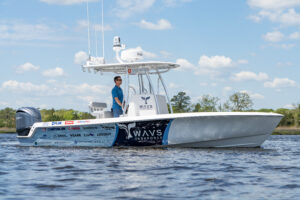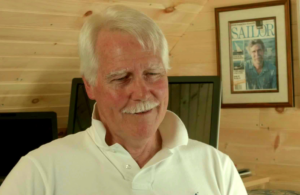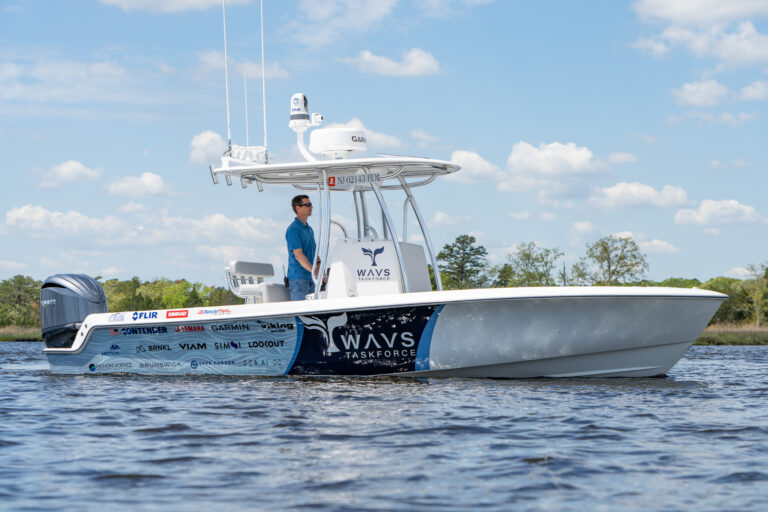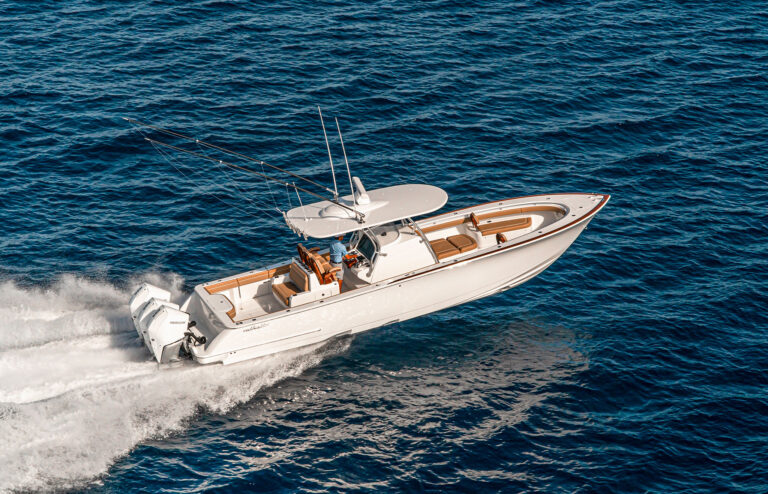So what kind of college offers no degrees, has no sports teams, no mascot, no ivy-covered walls, no professors and doesn’t charge tuition? Some fly-by-night Internet college? Nope. It’s PDQ U.
So what kind of college offers no degrees, has no sports teams, no mascot, no ivy-covered walls, no professors and doesn’t charge tuition? Some fly-by-night Internet college? Nope. It’s PDQ U.
The intense two-day preparatory is offered by PDQ Yachts each spring to its new Powercat 34 owners. You don’t have to attend PDQ U to buy one of their boats, but you do have to buy a boat to take the course. As I found out first-hand, taking the course is time well-spent. Unlike most builders who do a simple walk-through and a short run away from the dock, this is a well-organized, focused effort by a builder to give its owners a thorough preparation and orientation allowing them to take their new boats home with confidence.
PDQ Yachts of Whitby, Ontario, began more than 20 years ago as a sailing catamaran builder, and launched more than 150 sailboats. They still currently produce a semi-custom 44 sailing cat. In 2001 they introduced their Powercat 34, a totally new boat from the keel up. They had no idea the boat would take off as it has, becoming
90-percent of their production with nearly 100 built to date. Their power cats are proving so popular they intend to introduce a Powercat 41 this summer.
Because their boats are delivered on their bottoms, and Canada’s less-than-balmy winter weather turns Whitby’s harbor into a giant ice-skating rink, PDQ’s winter production typically cannot be splashed until mid-April. Three years ago the company began to organize a spring delivery flotilla of boats heading south. The level of experience of owners varied greatly and Rob Poirier, PDQ’s sales manager, found orienting multiple owners informally at the same time was proving increasingly difficult. He also noticed that the owners themselves were exchanging information and sharing experiences. With this he hit on the idea of PDQ U, and this May will see another graduating class.
Settling in
A record number of PC34s were commissioned in spring 2005, and by mid-May 14 PC34s were lined up on a pier at Whitby’s attractive town marina. I had shipped 35 boxes of gear up to Whitby earlier, and was less-than-enthusiastic about having to lug all the gear from its storage facility in town to my new boat. I had anticipated spending the better part of a day at this chore, but on arrival was delighted to find Debbie Slater, wife of the PDQ’s president Simon Slater, on the dock with a crew of eager local high school boys with pick up trucks. These fellows did in an hour what I thought would take me most of a day. Not only that, but they had scrubbed down every boat in anticipation of the owners’ arrivals, leaving each one spotless.
PDQ Yachts had earlier developed the flotilla idea to encourage their owners to do the long run south themselves.
“PDQ wants their boats being used and not sitting at a dock all season,” Rob Poirier says. “There is no better way to get owners used to long-range cruising than to start them out on an 800-mile cruise from Whitby to Annapolis. By the time they arrive they are confident and ready for more.”
From Annapolis many of the owners head even farther south on their own to their home ports, by then ready to solo cruise their new boat. To further facilitate this degree of comfort, PDQ provides a commissioning team to accompany the flotillas to address any items that can arise when a brand new boat makes an 800-mile run.
Meeting and greeting
Two long days of stowing and installing gear were the prelude to the beginning of PDQ U. More than 75 owners attended last year. Not all were departing on new boats, as many either had boats being delivered later in the year or had missed last year’s class. Most were couples. Ages ranged from the 40s to two owners in their 80s, with the majority in their 50s to early 60s. I couldn’t help but admire the Ontario octogenarian who at 86 had bought a new boat.
The boating experience of the owners ranged from 1 to 70 years. Many were making the transition from sail to power. Some were coming from slower displacement hulls and were attracted by the PC34’s 15-plus knot cruising speed. One previously had a 60-foot boat, and a few couples were moving up from smaller open powerboats with this their first cruising boat. They hailed from as far away as Wyoming and Puerto Rico. Most were from the east coast states ranging from Rhode Island south to Alabama. Florida was the most common state by far, where the boat’s shallow draft of 2 feet, 4 inches is ideal for the region’s thin waters.
All spoke of being attracted to the boat’s shoal draft, low fuel consumption of 4.5 gallons at 15 knots, and relatively spacious interior for a 34-footer. About one-third of the owners said they hadn’t known of the existence of the spring flotilla or PDQ U until after they bought their boat, although both events are well-published on the company’s Web site and participation is encouraged. Another third said they had known of both before buying and took this into consideration in selecting the boat. The final third liked the idea before buying, but didn’t consider it in making their choice of boats.
Class in session
We were divided into groups of six to eight. The “university” indoor classes were held in the attractive new clubhouse at the Whitby town marina. Though we took indoor classes together, the genders were divided for the on board classes with woman and male instructors. PDQ had found that separating the sexes made for more effective learning experience when it came to the hands on training, especially for the women who were spared any critical comments from their male counterparts. There were also probably more than a few husbands who were glad their wives didn’t witness their initial docking efforts.
Half a day was spent in maneuvering the boats under way, including docking. For those of us used to a low-profile sailboat with a single screw, and using both rudder and large bursts of power to dock coming to a 16-foot, 10-inch wide slab sided cat with lots of windage, twin screws, and only using gear shift levels to maneuver was something new. I was fortunate, getting a morning session before the breeze came up, but the day of my under way class the Canadian spring was spring in name only, and after a couple of hours and a series of successful dockings we were glad to return to the warm classroom.
Another half-day was spent on the boat crawling about and reviewing systems with Chris Calver, one of the company’s designers. The women worked with PDQ’s Vicki DeRusha. The instructors noted later that the ladies readily accepted Vicki’s information with few interruptions, but the men constantly interrupted Chris with questions. Why do you mount the inverter control panel so low? Why does Canada require all the waste to go into the holding tank first before a Y valve off the tank selects either deck pump out or overboard? Why run all the AC plugs through the inverter?
Chris had the answers, though, and usually managed to get back to where he had left off. Further, information was available in the detailed owner’s manual, and there was even a second ring binder filled with simple how-to directions and photos for most of the usual boat’s activities. On more than one occasion coming south I found the second manual’s simple step-by-step photos a great resource for a quick update addressing numerous activities, whether it was the valve and pump settings for fuel transfer between tanks, or simply the locations for various through-hulls.
Fitting out
The boats come with either a pair of 75-hp or 100-hp Yanmar turbo diesels, and most owners opt for the optional Northern Lights 5kw genset. Accordingly there was a class by the national distributors’ reps for both the engines and gensets. They arrived with actual engines and gensets on wheeled carts as well as an excellent PowerPoint presentation reviewing all the practical aspects of running and maintaining this equipment. Later the owners crowded around with more detailed questions as the reps kindly stayed on, and practical information of the sort seldom found in manuals was freely exchanged.
Most of the boat owners had gone with Raymarine autopilot and electronics packages. PDQ has a long history with this manufacturer and encourages owners in that direction, but especially suggests they not mix autopilots, radars and chart plotters from different manufacturers. Electronic gear often seems most happy interfacing within its own family, and past problems mixing brands had confirmed that in PDQ’s experience.
Accordingly, the Raymarine national distributor was there for another class. I had initially arrived aboard to find a 6-inch stack of Raymarine manuals, but their rep had dumbed them down, distributing a single ring binder of the most critical material that the owners really needed. Also, he emphasized calling him directly if there is any problem. I thought of dealing in the past with national electronic company hotlines where technical reps were only a 30-minute hold away. Even then after an endless wait I would sometimes receive an automated message to leave my number saying they’d get back to me, though usually when I wasn’t around to take the call.
Finally, Dan Rankin, PDQ’s production manager, offered an excellent class on the boat’s electrical systems. Again the manual and PowerPoint presentation were first-rate. A reflection of the company’s attitude was Dan giving his cell number to the owners to call if they had a problem. I reflected that for a customer to have a production manager’s personal cell number is in my experience pretty unusual.
Ready to cruise
The owners completed questionnaires the final day, and one thing was unanimous: PDQ U was a success. Couples who had little confidence came away feeling they were ready to take their boats south. Experienced boaters felt like they had saved endless hours on their own learning their boat. The proof came when 12 boats headed east the following day to Cobourg down Lake Ontario’s northern coast. From there, following a final dinner thrown by PDQ at the local yacht club, a four-boat flotilla went up the St. Lawrence River to Montreal and down through Lake Champlain to the Hudson, then on to Annapolis. My flotilla of eight boats crossed Lake Ontario and did the Erie Canal to the Hudson, before traveling down the New Jersey coast, up the Delaware Bay and finally south to the Chesapeake Bay.
Although our past boating experience varied, on such a long delivery run no one seemed to have any real problems running or maintaining the boats. We had along a PDQ commissioning team that added support, but any problems that arose were minor, especially considering we were running brand new boats hundreds of miles 8 to 12 hours a day.
PDQ Yachts refers to their boats as organic, as they are constantly changing and improving them. Likewise PDQ Yachts is already planning improvements to PDQ U and the flotillas for this year. (The PDQ U seminars are scheduled for May 15-16, with two flotillas departing afterwards.) The company’s attention to detail and willingness to go the extra yard in providing this educational service and organized flotillas for their owners really is something very special. As one owner said to me, “I bought the boat for its various qualities, but it was the existence of PDQ U that sold me that this was a company committed to its owners.” My experience at PDQ U confirmed that. www.pdqyachts.com










